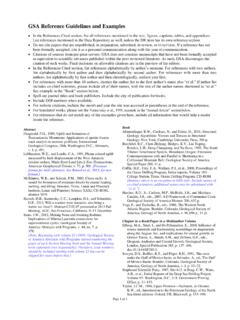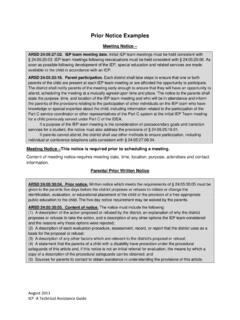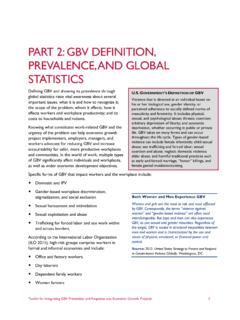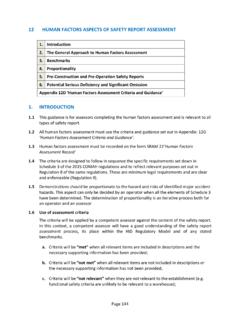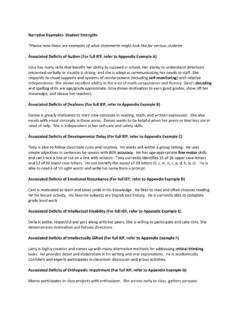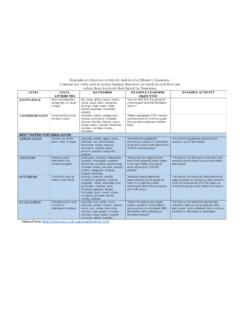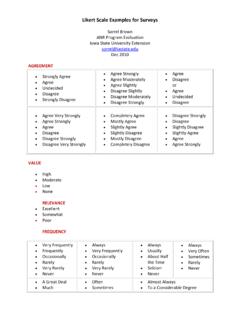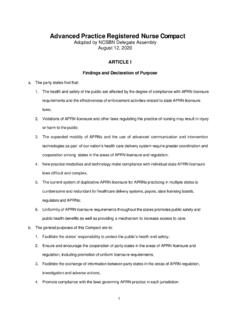Transcription of Examples of definitions of human rights violations*
1 Online course on United Nations human rights Responsibilities Module on What are human rights and Where Do They Come From? * Extracted from OHCHR s Glossary of International human rights and Humanitarian Law Violations For Internal use only please do not share or distribute. Examples of definitions of human rights violations* Extrajudicial execution or other killing Under the ICCPR everyone has the right to life and the right not to be arbitrarily deprived of his/her life. This right may not be suspended in times of emergency. Some of the most common forms of arbitrary killings are: if law enforcement officials deliberately kill a person when it is not strictly necessary to protect life (for example killing of peaceful protesters); killings committed by non-State actors, such as paramilitary forces or militias, who operate at the behest or with the acquiescence of State agents, and without the killings being strictly necessary to protect life; death sentences executed in violation of international law and standards; deaths in custody which result either from the use of force by public officials or from failure to protect the right to life of the detained person.
2 The deliberate use of force by law enforcement officials is limited to exceptional circumstances ( when necessary to protect life) and subject to strict conditions. If these conditions are not observed, killings by law enforcement officials may amount to extrajudicial executions, a form of arbitrary killing. States must prevent and investigate arbitrary killings, punish perpetrators and provide effective remedies to relatives. Relatives of victims of arbitrary killings are entitled to reparation, including adequate compensation, and the State must take measures to prevent further arbitrary killings. States also have an obligation to exercise due diligence to protect persons from threats to their lives by non-State actors, among other things by legislating to criminalize murder and through consistent enforcement of legislation. Public authorities must also take adequate measures of protection where they know, or ought to know, that lives are at risk.
3 ICCPR art. 6(1), CRC art. 6, CRPD art. 10, ICRMW art. 9, Convention on the Prevention and Punishment of the Crime of Genocide art. 1. UDHR art. 3; Basic principles on the use of force and firearms by law enforcement officials; Code of conduct for law enforcement officials; Principles on the effective prevention and investigation of extra-legal, arbitrary and summary executions. Rape Rape is a serious form of sexual violence or assault which consists of sexual penetration without consent, often by force or coercion. It may violate the right to security of the person, and the right to be protected from torture and other ill-treatment, among other human rights . Online course on United Nations human rights Responsibilities Module on What are human rights and Where Do They Come From? * Extracted from OHCHR s Glossary of International human rights and Humanitarian Law Violations For Internal use only please do not share or distribute. Rape consists of penetration of any part of the body of the victim or of the perpetrator with a sexual organ, or of the anal or genital opening of the victim with any object or any part of the body.
4 It is often, but not exclusively, perpetrated by force or the threat of force, or other forms of coercion. Consent is absent in coercive environments in which a person may not consent freely, in the case of children below the age of sexual consent, or if a person is unable to give consent ( due to being drugged). It is a violation of international human rights law if: rape is committed by a public official, or at the instigation or with the consent or acquiescence of a public official (in which case it would also amount to torture); or the State fails to ensure that cases of rape by State actors are effectively investigated and that, where there is sufficient evidence for prosecution, perpetrators are prosecuted and punished in accordance with the gravity of the offence; the State fails to exercise due diligence to adequately protect persons from rape by non-State actors, among other things by criminalizing all forms of rape, by establishing effective mechanisms for investigation and prosecution, and by implementing comprehensive awareness-raising programs.
5 Rape is perpetrated in different contexts, for example during interrogation or detention, in connection with domestic violence, against persons who have been subjected to trafficking or in armed conflicts. It affects women and girls disproportionately and as such may be a form of violence against women or gender-based violence. ICERD art. 5(b); ICCPR art. 7; ICESCR art. 12; ICRMW arts. 10, 16(1) and 16(2); CAT arts. 1 and 16; CRC arts. 19 and 37(a). UDHR arts. 3, 5; Declaration on the elimination of violence against women; General Assembly resolution 65/228, Updated model strategies and practical measures on the elimination of violence against women in the field of crime prevention and criminal justice. Failure to address domestic violence Domestic violence is violence committed in the home or private sphere, generally between persons belonging to the same family or household, and often between intimate partners. It is a violation of international human rights law if the State fails to: take effective measures to prevent domestic violence, among other things by: o establishing and enforcing specific legislation criminalizing domestic violence and providing for the protection of persons from harassment, intimidation, threats and violence; and o effectively investigating incidents of domestic violence and punishing the perpetrators in accordance with the severity of the offence; and o establishing comprehensive awareness-raising programs to prevent domestic violence; or establish effective systems to protect persons from real and immediate risks to life or integrity, where public officials know, or ought to know, that acts of violence are Online course on United Nations human rights Responsibilities Module on What are human rights and Where Do They Come From?
6 * Extracted from OHCHR s Glossary of International human rights and Humanitarian Law Violations For Internal use only please do not share or distribute. about to be committed (protective measures may include issuing exclusion orders or detaining potential perpetrators if other means are ineffective to protect the life or integrity of persons). Domestic violence is based on unequal power relations between perpetrators and victims; such as between men and women, between adults and children, or between employers and domestic workers. Domestic violence may keep a person in a permanent state of fear in order to reduce him/her to submission and can share many characteristics of torture. Domestic violence disproportionately affects women and girls and is rooted in and exacerbated by discrimination in law and practice. Preventing and effectively responding to domestic violence requires a gender-inclusive approach which takes account of discrimination, gender roles and power relations.
7 ICCPR art. 7; CAT arts. 1 and 16; CEDAW art. 2; CRC arts. 19 and 37(a); ICRMW arts. 10 and 16(2). UDHR art. 5; Declaration on the elimination of violence against women; General Assembly resolution 65/228, Updated model strategies and practical measures on the elimination of violence against women in the field of crime prevention and criminal justice. Arbitrary detention The right to liberty and security of the person includes freedom from arbitrary or unlawful detention. Detention is the involuntarily confinement of a person to a limited physical space and may take a variety of forms. A person may be confined to a police or prison cell, to his/her own house (house arrest) or, for instance, to a closed hospital ward or immigration facility. Detention may take place in the context of a criminal justice process or for other reasons, such as immigration control, when necessary for the prevention or spread of infectious diseases, or for the protection of intoxicated persons.
8 The right not to be subjected to arbitrary or unlawful detention applies to all forms of detention by the State or attributable to the State. It is a violation of international human rights law if a detention is: not in accordance with national laws (unlawful), because it is o not properly based on grounds established in a pre-existing law; or o not in accordance with the procedures established by law; or otherwise arbitrary in the sense of being inappropriate, unjust, unreasonable, or unnecessary in the circumstances. Whether a detention is unlawful and/or arbitrary must be assessed on an individual basis in light of all the circumstances of a case. If a person is detained as a punishment for, or to deny, the exercise of human rights (such as expressing political opinions or peacefully demonstrating), the detention is arbitrary, as are detentions on discriminatory grounds ( , if a person is detained on account of a disability, or because s/he belongs to a particular ethnic group).
9 Online course on United Nations human rights Responsibilities Module on What are human rights and Where Do They Come From? * Extracted from OHCHR s Glossary of International human rights and Humanitarian Law Violations For Internal use only please do not share or distribute. The right to liberty may be subject to derogation during a state of emergency but States must not undermine the protection of non-derogable rights , nor contravene other international obligations, such as the prohibition of unlawful confinement during armed conflicts. Among other things, detained persons must at all times retain the right to challenge the legality of their detention, and the grounds and procedures for a detention must be established by law. A person who has been arbitrarily or unlawfully detained has an explicitly recognized right to compensation. ICCPR art 9; CRC art. 37(b); ICRMW art. 16(1),(4); CRPD art. 14; CPED art. 17; CAT art. 11; UDHR arts. 3 and 9; Body of Principles for the Protection of All Persons under Any Form of Detention or Imprisonment.
10 Forced evictions Forced evictions violate a range of international human rights norms, including the right to adequate housing. Forced eviction occurs where a person, group or community is involuntarily removed from their home and/or land they occupy (permanently or temporarily), without appropriate legal and procedural protections. Not all evictions are prohibited under international law. Circumstances such as a tenant s persistent non-payment of rent, or compelling safety reasons may justify an eviction, provided it is carried out in compliance with domestic and international law. Evictions amount to forced evictions and are thus prohibited, if: They are not based on a justification set out in national law which is sufficient under international law; or Where there has not been compliance with legal processes; or They are not limited to exceptional circumstances; or There has not been proper consultation with the affected individual/community; or Persons have not been afforded due process, including the ability to challenge the legality of the eviction; or They are otherwise carried out in violation of international human rights law, for example if they are carried out in a discriminatory manner, or if they render persons homeless or leave them vulnerable to other human rights violations.







